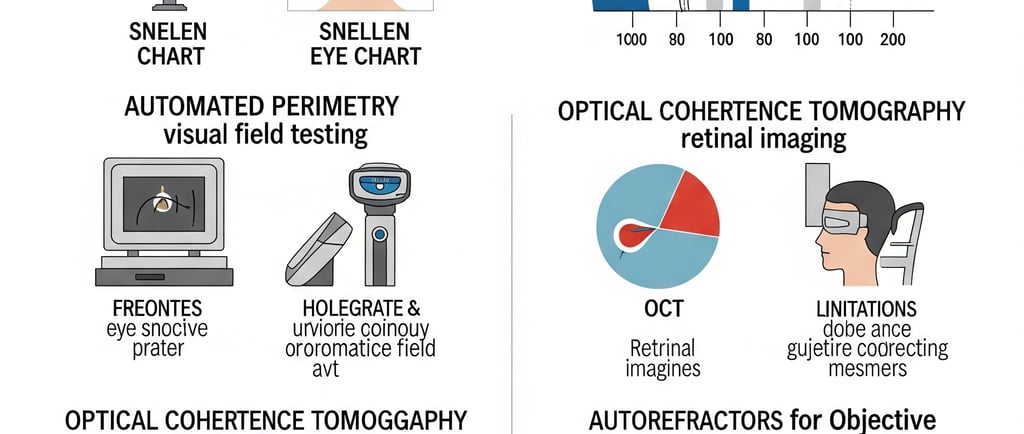Current methods of measuring vision - How important are regular eye exams?
2/6/20257 min read


Understanding Vision Measurement
Vision measurement is a critical aspect of eye health that involves assessing an individual's eyesight using various methods and metrics. It provides a comprehensive understanding of one's visual capabilities, which is vital for overall health. One of the foundational components of vision measurement is visual acuity. This term refers to the clarity or sharpness of vision, often evaluated through standardized tests such as the Snellen chart. Individuals typically read letters at a specific distance to determine their visual acuity, expressed as a fraction, which indicates how well one sees compared to a standard measurement.
Another crucial concept in vision measurement is refractive errors. These errors occur when the shape of the eye prevents light from focusing directly on the retina, leading to blurred vision. Common types of refractive errors include myopia (nearsightedness), hyperopia (farsightedness), and astigmatism. Identifying these errors is essential since they can significantly affect daily activities like reading, driving, and working on screens. Eye care professionals employ advanced techniques, such as corneal topography and wavefront analysis, to assess these conditions accurately.
Understanding vision measurement is vital for maintaining optimal eye health and addressing any potential issues early. Regular eye exams enable the detection of changes in vision that might not be noticeable immediately. Furthermore, they provide insights into an individual's overall health, as some eye conditions can signify more systemic health problems. Therefore, incorporating routine vision assessments into personal healthcare regimens is essential for ensuring long-term eye wellness and enhancing quality of life.
Common Methods of Measuring Vision
Vision assessment is a critical component of eye care, allowing for the detection of potential issues and determination of the appropriate corrective measures. Various methods are employed to measure vision, each with its own set of benefits and limitations.
One of the most traditional techniques for measuring visual acuity is the Snellen chart test. This method involves reading letters of decreasing size from a fixed distance, typically 20 feet. The results are expressed as a fraction, indicating how well a person can see compared to standard vision. While the Snellen chart is widely used and easy to administer, it primarily assesses distance vision and may not provide an accurate representation of a person’s overall visual function.
In recent years, technological advancements have introduced modern vision testing methods, such as digital vision tests. These methods utilize computer-based systems to present visual stimuli, providing a more comprehensive analysis of visual acuity, including color perception and contrast sensitivity. Digital tests can be more engaging and less intimidating for patients, fostering a more thorough examination.
Automated refractors represent another significant advancement in vision measurement. These devices use light waves and sensors to determine the optimal lens prescription for correcting refractive errors such as myopia, hyperopia, and astigmatism. Automated refractors enhance the accuracy of measurements and can streamline the process by reducing the time spent during eye exams. However, they may not always capture nuanced visual issues that a skilled optometrist might identify through empirical observation during a detailed examination.
Overall, while traditional methods like the Snellen chart test remain relevant, modern approaches such as digital tests and automated refractors are enhancing the way vision is measured. Each method has its own strengths and weaknesses, underlining the importance of comprehensive eye exams that might combine different techniques to ensure an accurate understanding of an individual’s visual health.
The Role of Regular Eye Exams
Regular eye exams are a fundamental component of maintaining overall health and well-being. They serve not only to assess vision but also to detect underlying health conditions that may otherwise go unnoticed. The significance of these examinations cannot be overstated, as they play a crucial role in the early identification of vision problems and systemic diseases such as diabetes and hypertension.
During a comprehensive eye examination, eye care professionals utilize various methods to evaluate a patient's visual acuity, eye coordination, and overall eye health. These assessments are vital for detecting common issues like refractive errors, glaucoma, and macular degeneration. Furthermore, the eyes can often reveal signs of systemic health issues. For instance, changes in the retinal blood vessels can indicate high blood pressure or conditions like diabetic retinopathy, allowing healthcare providers to offer timely intervention.
The correlation between regular eye examinations and the prevention of serious vision impairments is significant. Studies have shown that individuals who undergo routine eye check-ups are more likely to detect vision-related problems early, thus enabling timely treatment that can mitigate the risk of severe complications. This proactive approach not only preserves vision but overall enhances the quality of life.
Additionally, the frequency of these examinations is essential. The American Optometric Association recommends that adults aged 18 to 64 have their eyes checked every two years, while those over 65 should have annual screenings. For individuals with pre-existing conditions or a high risk of eye diseases, more frequent assessments may be necessary. In summary, regular eye exams are imperative for safeguarding eye health and detecting potential health issues early on, making them a crucial aspect of comprehensive health care.
Who Should Get Regular Eye Exams?
Regular eye exams are essential for maintaining optimal eye health and detecting potential issues early. Various demographics should prioritize these examinations based on specific factors such as age, medical history, and individual risk factors. Children, seniors, and individuals with a family history of eye diseases constitute the primary groups that should be particularly vigilant regarding their eye health.
For children, regular eye exams are crucial for identifying vision problems that may affect their learning and overall development. The American Academy of Pediatrics recommends that infants have their first eye assessment at around six months of age, followed by additional screenings at age three and just before entering school. Early detection of conditions such as amblyopia or refractive errors can lead to more effective interventions, thus enhancing a child's quality of life.
Seniors, generally those aged 65 and older, are also at a greater risk of developing age-related eye conditions such as glaucoma, macular degeneration, and cataracts. According to studies, one in six individuals in this age group will experience vision loss due to these concerns. As such, it is recommended that seniors undergo comprehensive eye exams at least once a year, allowing for early detection and management of any emerging issues.
Moreover, individuals with a family history of eye diseases or other risk factors such as diabetes, hypertension, or previous eye injuries should schedule regular examinations tailored to their specific needs. Early consultations with an eye care professional can help in understanding personal risks and establishing a customized schedule for check-ups. By adhering to these recommendations, these at-risk groups can effectively monitor their eye health and address potential issues before they lead to severe complications.
Advancements in Eye Care Technology
The field of eye care has witnessed several groundbreaking advancements in technology, all aimed at enhancing the accuracy and efficiency of vision measurements. Tele-optometry, for instance, has emerged as a revolutionary approach, particularly in remote areas where access to traditional eye care facilities may be limited. This innovative method allows optometrists to conduct eye exams through digital platforms, enabling patients to receive care from the comfort of their homes. By leveraging video conferencing technology, not only is patient engagement improved, but also the potential for early diagnosis and treatment of vision-related issues is significantly increased.
Moreover, the integration of artificial intelligence (AI) into ocular diagnostics has marked a notable shift in the way vision impairment is detected and assessed. AI-driven systems are capable of analyzing vast amounts of data far more swiftly and accurately than their human counterparts, leading to timely interventions for conditions such as glaucoma and diabetic retinopathy. These intelligent algorithms utilize machine learning techniques to identify patterns in imaging data, resulting in more precise diagnoses and tailored treatment plans. As these AI systems continue to evolve, their role in eye care is anticipated to grow, further enhancing the level of care provided to patients.
In addition to tele-optometry and AI, advancements in imaging techniques also play a crucial role in modern eye care. High-definition optical coherence tomography (OCT), for example, provides detailed cross-sectional images of the retina, allowing eye care professionals to detect and monitor diseases at their nascent stages. This technology not only enhances the diagnostic process but also improves the ability to track the effectiveness of treatment over time. Collectively, these technological developments are set to redefine patient care in the realm of eye health, making vision measurement more accessible and accurate than ever before.
Signs You Need an Eye Exam
Recognizing when to seek a professional eye exam is crucial for maintaining optimal eye health. There are several signs and symptoms that may indicate a need for a vision assessment. One of the most common indicators is blurry vision, which can manifest as difficulty in focusing on objects at various distances. This condition may be a sign of refractive errors such as myopia, hyperopia, or astigmatism, and should be assessed by an eye care professional.
Another prevalent issue is eye strain, often experienced by individuals who spend extended periods in front of screens. Symptoms include discomfort, fatigue, and headaches, frequently referred to as digital eye strain or computer vision syndrome. Persistent eye strain may warrant an eye exam to determine if corrective lenses or changes in digital habits are necessary to alleviate the discomfort.
Changes in perception, such as increased sensitivity to light or challenges in differentiating colors, are also important signs to consider. These changes can indicate underlying conditions that affect vision, and timely intervention is essential to prevent further complications. Additionally, if one notices frequent headaches, difficulty seeing at night, or if the vision appears to be distorted, these symptoms should not be ignored.
It is advisable to schedule an eye exam if one experiences any of these signs. Regular assessments, typically recommended every one to two years, become even more crucial as individuals age or if there is a family history of eye diseases. Proactively addressing these symptoms through professional evaluation can lead to early detection and treatment of potential vision problems, ultimately preserving eye health.
Conclusion: Prioritizing Eye Health
In conclusion, the significance of regular eye exams cannot be overstated. Maintaining optimal eye health is an essential aspect of overall well-being. Throughout this blog post, we have explored various current methods of measuring vision, highlighting how these techniques contribute to early detection and effective management of potential eye disorders. Routine eye check-ups serve as a critical preventive measure, allowing for the timely identification of conditions such as glaucoma, macular degeneration, and diabetic retinopathy, which can profoundly impact quality of life if left unmonitored.
Moreover, the advancements in vision measurement techniques, ranging from standard visual acuity tests to more sophisticated imaging technologies, underscore the importance of regular assessments. These methodologies provide a comprehensive understanding of an individual's eye health, ensuring that any changes in vision are promptly addressed. By engaging in regular eye exams, individuals can take an active role in preserving their sight and overall health, demonstrating that proactive care is paramount when it comes to eye-related issues.
We encourage readers to incorporate routine eye screenings into their healthcare regimen, irrespective of age or existing vision problems. Eye health can easily be overlooked, yet it plays a pivotal role in daily life, affecting everything from mobility to emotional well-being. By making eye care a priority, individuals can ensure they maintain a high quality of life, free from the hindrances of unaddressed visual impairments. Ultimately, investing time in regular eye examinations is not merely a recommendation; it is an essential practice for safeguarding one of our most precious senses—our vision.
